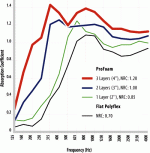It will affect all lower frequencies I'd expect, but I don't think that is the solution to the problem.
I've been exprimenting quite heavily with dipole speakers lately (I even have a small set of Computer diople speakers LOL) and I've found that baffle vibration causes most of the "bumps" in the response. (especily with drivers that have low fs)Damp and brace the baffle as much as possible.
My main dipoles are 1:1.6 ratio dimentions for the baffle with the driver positioned in the baffle with that ratio as well, also expriment with the placement, they need plenty of room behind to "breathe".
I've been exprimenting quite heavily with dipole speakers lately (I even have a small set of Computer diople speakers LOL) and I've found that baffle vibration causes most of the "bumps" in the response. (especily with drivers that have low fs)Damp and brace the baffle as much as possible.
My main dipoles are 1:1.6 ratio dimentions for the baffle with the driver positioned in the baffle with that ratio as well, also expriment with the placement, they need plenty of room behind to "breathe".
There has been some discussion of the baffle vibration "helping" the bass if done right. But I think that is a very tricky area to get right.Better to stick with rigid, I agree. There are quality of sound issues also- It is possible to get a flat frequency response yet have portions of that response be quite flabby I'd think. The reverse is true of some full range drivers I think- at some frequencies , the sound measures flat or
a peak, but much of the energy is from a huge resonance, and the quality suffers.
The issue of holes in the baffle is essential to study, yet we are barely getting accurate info in how big a baffle is required. I think the main problem is that the parameters are often undefined.
ie is it on the floor?
is part of the width "wings" at right angles to the main baffle? (which might not work as well as we thought)
What are the driver specs-especially damping?
Are there cracks/hole in the baffle and how wide/big?
Probably, like me we are just tooo busy? Well when do people make their projects? (I don't even have much time for that!)
Boy, it is amazing to me that no one is tempted by such a concise group of questions that could be investigated by some student (great for a paper ) or hobbyist with 4 sheets of MDF, a computer freq response measuring system, and a couple of pairs of drivers.
That person would become almost famous in our little corner...
a peak, but much of the energy is from a huge resonance, and the quality suffers.
The issue of holes in the baffle is essential to study, yet we are barely getting accurate info in how big a baffle is required. I think the main problem is that the parameters are often undefined.
ie is it on the floor?
is part of the width "wings" at right angles to the main baffle? (which might not work as well as we thought)
What are the driver specs-especially damping?
Are there cracks/hole in the baffle and how wide/big?
Probably, like me we are just tooo busy? Well when do people make their projects? (I don't even have much time for that!)
Boy, it is amazing to me that no one is tempted by such a concise group of questions that could be investigated by some student (great for a paper ) or hobbyist with 4 sheets of MDF, a computer freq response measuring system, and a couple of pairs of drivers.
That person would become almost famous in our little corner...
Are you thinking of this as the analog of a diffraction grating for light?
Well I'm almost sure a whole in the baffle wont act as a filter that will block all frequencies whose wavelenght is longer or shorter than the distance from the driver to the hole.
[Hey, you make me think (off topic) but can't we pass many light signals in one glass fiber using this method?and split them at the end?]
But depending on how its made, it could probably de made to affect only a range of frequencies.
(maybe some sort of passive baffle step correction??).
I'll think about it some more, and probably will dig up some mdf.
I have some free time this week end.
There has been some discussion of the baffle vibration "helping" the bass if done right.
Passive radiators?
Here is another idea. Put a sound absorber behind the dipole speaker. You want very little absorption below 100 Hz, but significant attenuation at the frequencies where the first 'diple dip' occurs. This should smooth out the upper end a bit, but still retain the advantage of the dipole topology at lower frequencies.
Attachments
- Status
- This old topic is closed. If you want to reopen this topic, contact a moderator using the "Report Post" button.
